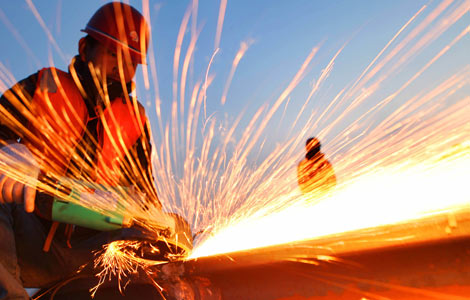
BEIJING - China has announced its readiness to approve with caution new nuclear power projects, a move that bolsters the government's resolve to fuel rapid economic growth while striving to meet carbon emission cut targets.
About one-and-a-half years after China began, in March 2011, to halt approvals of new nuclear projects due to the Fukushima catastrophe, the latest decision by the State Council, China's cabinet, to lift the ban meant concerns over possible radioactive contamination finally gave way to endeavors to optimize the country's energy structure amid high demands.
It is also expected to help China fulfill its commitment about cutting carbon dioxide emissions per unit of GDP by 17 percent from 2010 to the end of 2015. Then further by 40 to 45 percent by 2020 from the 2005 level, a demanding task if the government intends to sustain high economic growth.
The new plan, unveiled at the State Council executive meeting that discussed and passed the Nuclear Power Safety Plan (2011-2020) and the Mid- and Long-term Development Plan for Nuclear Power (2011-2020), did not catch much attention from members of the public, suggesting many have recovered from being overwhelmingly afraid to cool-headed.
China's population and rapid economic growth places huge demands on energy, with the country's primary output equaling 3.18 billion tonnes of standard coal in 2011, ranking it first in the world.
Output of natural gas and crude oil also ballooned. Imports of the two energy resources are expected to further rise due to limited domestic findings and the construction of more transmission pipes.
Although traditional energy is so far in no immediate danger of severe shortage, China must act sooner than later to develop alternative energy to avoid paying heavier prices, most notoriously air pollution, for consuming coal and oil.
In recent years, China has already quickened steps to tap new energy reserves. In 2011, installed generative hydropower capacity reached 230 million kilowatts (kw), ranking it first in the world. Wind power reached an installed generative capacity of 47 million kw.
But over time, problems have surfaced about overcapacity in new energy industries caused by poor overall designs. The bankruptcy bid of Suntech, one of the largest solar photovoltaic manufacturers in China, is seen as a heavy blow to the industry.
Nuclear energy, unpredictable as it may be, is also known for being highly productive and clean, if no accidents like explosion or leakage occur.
As nuclear energy accounts for about 1.8 percent of China's total power output, there is room for further development. The key question is how to minimize risks.
The new plans explicitly stated that no nuclear projects would be constructed in inland regions in the coming five years and that adequate justification processes are a prerequisite for new projects. The documents also stressed that China should constantly carry out safety upgrades on currently operating reactors and use the most advanced mature technologies.
These are solemn promises, of course, but down to details, strict supervision is indispensable to ensure things go right. After all, as the State Council said in a statement, "Safety is the lifeline of nuclear power."







